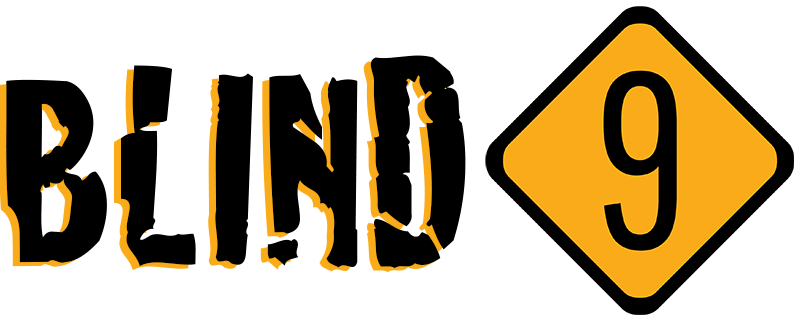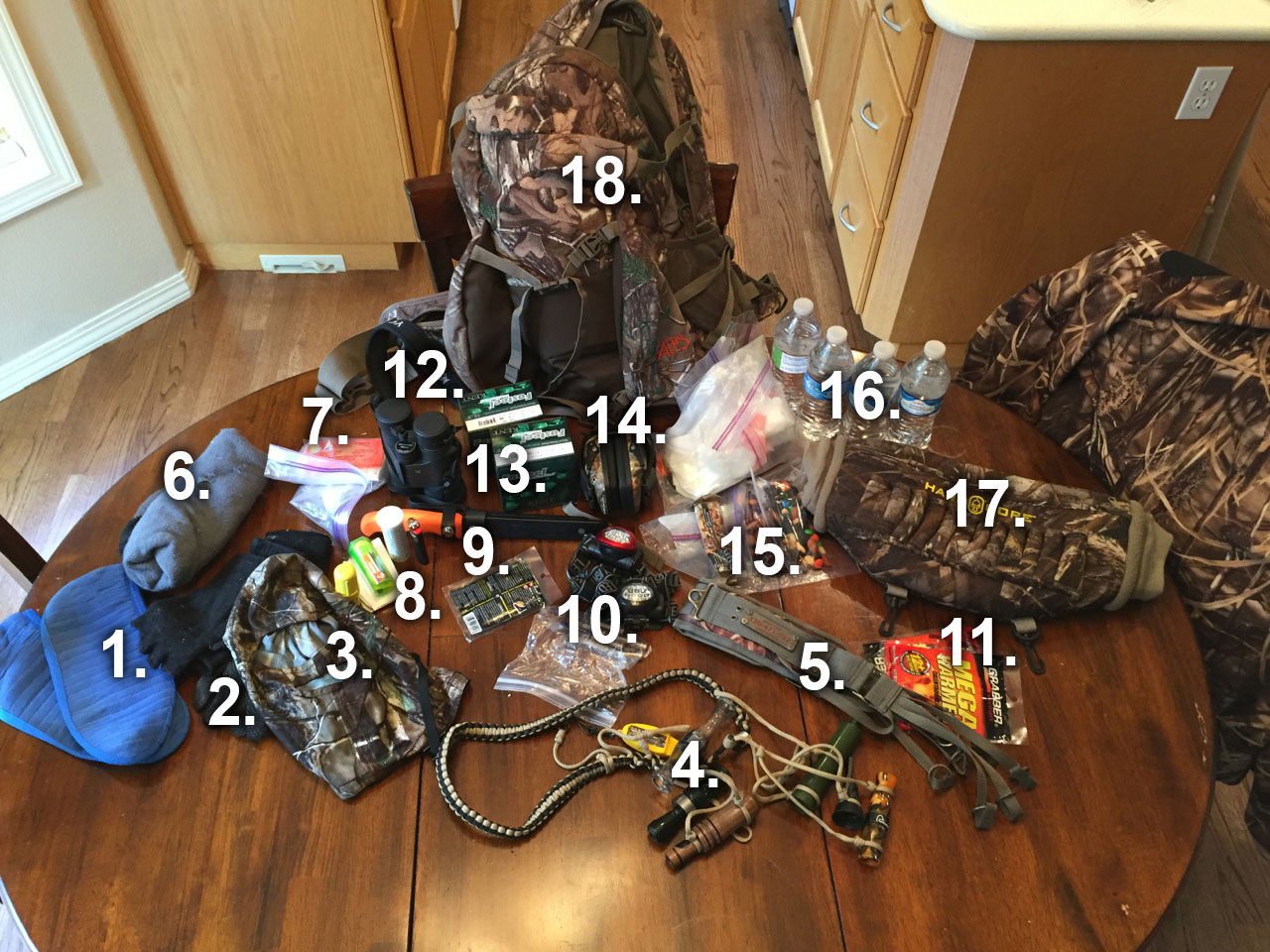I was getting ready for our first duck hunt of the season and disgorged my blind bag to take inventory and re-stock where needed. I always feel like I pack way too much, but I don’t like being un-prepared or cold. So here is what you might find in my bag near the end of the season. I will pack lighter earlier as I won’t need the cold-weather gear. I’ve linked to many of these items on Amazon, but you can buy many of them at your local outfitter store.
1. Boot Liners
I use the Honeywell Bama Sokket, which I bought based on a recommendation I read online when I was looking for better wool socks. You put these on over your wool socks and they wick sweat and water away from from your feet. They work great and keep my feet much warmer than doubling up on socks.
2. Gloves
You’ll see two types of gloves here. The larger one are called SealSkinz gloves, which are lightweight, waterproof glove liners that I use when I’m deploying or retrieving decoys. They run large so order a size down. The other pair are simply wool fingertip gloves, which I wear during the hunt. They keep my hands warm but I keep dexterity in my fingers for shooting and reloading. I buy mine at Army surplus stores and always have a few pair laying around the house.
3. Facemask
This is a thin-material bug proof facemask, which I use throughout the season here in the Northwest. It rarely gets so cold that I need more than this and a hood on my jacket. You have to lift up the bottom to call with it, but it’s not tight. You can also choose a half mask, which several of my buddies use. You have to pull it down to call through it, but they prefer it.
4. Call Lanyard w/ Various Calls
Since I take a good number of calls with me, this lanyard has come in pretty handy, although it seems the right call is never the one I grab first. My lanyard came with double-loops in case one comes off (they do!) and a yellow emergency whistle. I got it on sale at Dick’s sporting goods after the season. Here’s a similar one on Amazon.
Duck calls: As for the calls, I’ve got a bunch now, and most of what I use now are not in this photo. My go-to duck call is the Flextone Supernatural. It handles loud and soft pretty well and I can make some OK duck sounds on it. I also use a mallard drake call, and a 6-in-1 whistle, which came in a pack with another small call that I don’t use anymore. I’m not convinced that my calling is being held back by these less-expensive calls. And the whistle has been a must-have, especially for pintails in our area. A few more years of practice and I might find a need for something more.
Goose calls: For goose, I’ve got three different calls. This goose flute, which is a really easy-to-learn first goose call. Then I’ve got a louder, slightly harder to learn, Rich-N-Tone single reed goose call, which I learned to blow in a few months. Finally, I’m still trying to master this expensive Bill Saunders cackler call, which I know works great because I’ve heard other hunters use it. I’m not there yet!
5. Game Strap
You’ve got a couple of choices with waterfowl game straps, which really do help when you’ve got 50lbs-60lbs of birds you need to carry a mile or two. You can go for the slip ring design, which is what I use because you can use it on feet or necks. Or you can use the metal loop design, which is easier to deal with but does not work as well on feet. Either way, they work a lot better than bags or carrying birds with your hands.
6. Wool Socks
These are a no-brainer for me. If my feet are cold, I’m cold. And it took me a couple of seasons to find a high-wool content wool sock that was still soft and comfortable. These Carhartt high wool boot socks are 68% wool, which retains 70% of its warmth retention when wet. I’ve found them to be ideal for hunting in the Pacific Northwest. Be careful what “wool” socks you buy, as many of the blends feature 20% or less wool and leave your feet cold in your boots! Check the description or labels before you buy.
7. Game Licenses and Extra Baggies
I pack my licenses and anything else I don’t want to get soaked in simple quart-sized baggies. I carry a couple of spares.
8. Wader Repair Kit and First Aid Kit
You generally notice a pin hole leak in your waders first thing in the morning while putting out decoys. Don’t suffer! If you know where the leak is you can seal it with this repair kit. In the meantime, seal holes in your person with a simple first aid kit. Oh, and since I’m well over 40, I also pack a bottle of ibuprofen.
9. Knife
My brother-in-law gave me this Cutcu filet knife with a sheath that contains a sharpening stone, line cutter, and opens to be a fish hanger. It’s easy to sharpen and makes quick work of cleaning ducks (and fish). Mine has an orange handle and unless I lose it I suspect I’ll never need another one.
10. Flashlights / Headlamps
I wear a headlamp on the walk out to the blind. I also carry a back-up light that’s more powerful. There’s a bazillion cheap Chinese-made lights all over Amazon. For this season I changed to this headlamp and this hand-held light, both because they are inexpensive, water resistant, and use AAA batteries, which is what my ear protection uses. Also, I’m not going to get too frustrated if I drop one in the muck and lose it. But if I wanted something that would ruin my day if I lost it, it would be this one.
11. Hand Warmers
The bigger the better for hand warmers. I stuff a big one into my hand muff during cold hunts. I use the old-fashioned ones, but you could also try these rechargeable ones. I’ve got a buddy who uses this fueled warmer by zippo. The fueled one kinda freaks me out, but he likes it.
12. Binoculars
Sometimes I think I pack too much stuff for a duck hunt and bulky binoculars are the first thing I think about eliminating. And yet, I use them every hunt, especially for identification of birds or looking at other wildlife while sitting in the blind. Mine are the Vortex Diamondback 10×42. They’re a good mid-level choice and are waterproof and fogproof with a lifetime warranty from Vortex. I’ve found the 10×42 the most versatile when balancing weight versus performance. I’ve had them for eight seasons now and they’re still working great.
13. Ammunition
Early in my hunting exploits I tried everything, from cheap steel to high-priced tungsten shells. What I learned was that the ammunition wasn’t the solution to my shooting woes. I learned if I took closer shots I got more birds and fewer cripples. Now I pay less attention to shells and more attention to decoy set-ups and shot selection. That said, I’ve never had a problem with Kent Fasteel, which is what I usually buy because it’s inexpensive and has worked every time for me.
14. Ear Protection
I’ve listened to a lot of loud music through the years and the constant tinnitus is my reward. So to protect what’s left I always wear hunting hearing protection. You can go with the super cheap foam earplugs, but I like the electronic game muffs. The electronic muffs can be set to amplify sounds, which helps my hindered hearing, but cut out when a loud noise hits them. They work amazingly well. The guys and I can talk normally in the blind and can hear approaching birds much easier. But when the shooting starts we get the protection we need. I got the cheaper ones my first season and they almost always failed on the second shot. So now I have this Howard Leight brand. I’ve gone through three seasons with them and so far no problems. They take AAA batteries, which is what I use in all my flashlights, too.
15. Snacks
Granola, PB&Js, whatever. If you’re feeling salty, bring some of last years duck pepperoni.
16. Water
I will go through a couple of bottles in 4-6 hours of hunting.
17. Hand Muff
I don’t start packing the handwarmer muff until it gets pretty cold. What’s nice about it is I can stuff the pockets with hand warmers, calls, and a spare pair of fingerless gloves. This browning version has a belt so it’s easy to keep your hands in it while you’re sitting.
18. Backpack
My first season I used a basic blind bag. As I began to pack more gear, I moved to this Aps backpack (pictured), which worked well but did not have the space I wanted. This season I replaced that pack with a larger Drake Waterfowl backpack, which also features a number of compartments. Perhaps not everything I try to find will be at the very bottom of the pack. The Alps was water resistant, so if I spent a rainy day in an open pit blind my stuff would get wet eventually. The same is true of the Drake pack. I’ve used it for a couple of seasons now and it’s still going strong with no broken zippers or ripped straps.

